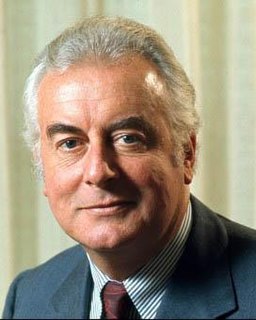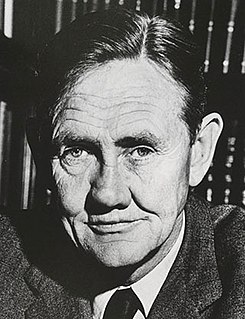
Robert James Lee Hawke was an Australian politician who served as the 23rd prime minister of Australia from 1983 to 1991, holding office as the leader of the Australian Labor Party (ALP).

Edward Gough Whitlam was the 21st prime minister of Australia, serving from 1972 to 1975. The longest-serving leader of the Australian Labor Party (ALP), he was removed as prime minister after controversially being dismissed by the governor-general of Australia, Sir John Kerr, at the climax of the 1975 Australian constitutional crisis. Whitlam is the only Australian prime minister to have been removed from office in this manner.

The Liberal Party of Australia is a major centre-right political party in Australia, one of the two major parties in Australian politics, along with the centre-left Australian Labor Party. It was founded in 1944 as the successor to the United Australia Party.

John Malcolm Fraser was an Australian politician who served as the 22nd prime minister of Australia, in office from 1975 to 1983 as leader of the Liberal Party of Australia.

The prime minister of Australia is the head of government of Australia. The prime minister is the leader of the executive branch of the federal government of Australia and is also accountable to federal parliament under the principles of responsible government. The incumbent prime minister is Scott Morrison, who took office in August 2018 as leader of the Liberal Party.

The 1975 Australian constitutional crisis, also known simply as the Dismissal, culminated on 11 November 1975 with the dismissal from office of the Prime Minister, Gough Whitlam of the Australian Labor Party (ALP), by Governor-General Sir John Kerr, who then commissioned the Leader of the Opposition, Malcolm Fraser of the Liberal Party, as caretaker Prime Minister. It has been described as the greatest political and constitutional crisis in Australian history.

Sir John Robert Kerr was an Australian barrister and judge who served as the 18th Governor-General of Australia, in office from 1974 to 1977. He is primarily known for his involvement in the 1975 constitutional crisis, which culminated in his decision to dismiss the incumbent prime minister Gough Whitlam and appoint Malcolm Fraser as his replacement, unprecedented actions in Australian federal politics.

Andrew Sharp Peacock was an Australian politician and diplomat. He served as a cabinet minister and went on to become leader of the Liberal Party on two occasions, leading the party to defeat at the 1984 and 1990 elections.

Sir Billy Mackie Snedden, was an Australian politician who served as the leader of the Liberal Party from 1972 to 1975. He was also a cabinet minister from 1964 to 1972, and Speaker of the House of Representatives from 1976 to 1983.

The 1996 Australian federal election was held to determine the members of the 38th Parliament of Australia. It was held on 2 March 1996. All 148 seats of the House of Representatives and 40 seats of the 76-seat Senate were up for election. The centre-right Liberal/National Coalition led by Opposition Leader John Howard of the Liberal Party and coalition partner Tim Fischer of the National Party defeated the incumbent centre-left Australian Labor Party government led by Prime Minister Paul Keating in a landslide.
This is a list of members of the Australian House of Representatives from 1975 to 1977. The 13 December 1975 election was a double dissolution of both Houses, with all 127 seats in the House of Representatives, and all 64 seats in the Senate were up for election. Malcolm Fraser had been commissioned as prime minister following the dismissal of the Prime Minister Gough Whitlam's three-year-old Labor government by Governor-General Sir John Kerr, on 11 November 1975. The same day, Fraser advised the calling of the election, in accordance with Kerr's stipulated conditions. Thus the Liberal Party of Australia, led by Fraser, with coalition partner the National Country Party, led by Doug Anthony, went to the election as a minority caretaker government. The election resulted in the Coalition securing government with a 30-seat swing in the House of Representatives away from Labor.

A double dissolution is a procedure permitted under the Australian Constitution to resolve deadlocks in the bicameral Parliament of Australia between the House of Representatives and the Senate. A double dissolution is the only circumstance in which the entire Senate can be dissolved.
Kevin Eugene Newman AO was an Australian soldier and politician. He was a member of the Liberal Party and held ministerial office in the Fraser Government, serving as Minister for Repatriation (1975–1976), Environment, Housing and Community Development (1976–1977), National Development (1977–1979), Productivity (1979–1980), and Administrative Services (1980–1983). He represented the Tasmanian seat of Bass in the House of Representatives from 1975 to 1984. His wife Jocelyn also became a federal government minister, while his son Campbell became premier of Queensland.

John Winston Howard is an Australian former politician who served as the 25th prime minister of Australia from 1996 to 2007, holding office as leader of the Liberal Party of Australia. His eleven-year tenure as prime minister is the second-longest in history, behind only Sir Robert Menzies, who served for eighteen non-consecutive years. He has also been the oldest living former Australian prime minister since the death of Bob Hawke in 2019.

The history of Australia since 1945 has seen long periods of economic prosperity and the introduction of an expanded and multi-ethnic immigration program, which has coincided with moves away from Britain in political, social and cultural terms and towards increasing engagement with the United States and Asia.

The 1983 Australian federal election was held in Australia on 5 March 1983. All 125 seats in the House of Representatives and all 64 seats in the Senate were up for election, following a double dissolution. The incumbent Coalition government which had been in power since 1975, led by Malcolm Fraser and Doug Anthony, was defeated in a landslide by the opposition Labor Party led by Bob Hawke. This was the first of 5 consecutive election victories for the Labor party. This election marked the end of the 3 term 7 year Liberal-National Coalition Fraser Government and started the period of the 5 term 13 year Hawke-Keating Labor Government. The Coalition would spend its longest ever period of opposition and the Labor party would spend its longest ever period of government at the federal level. The Coalition would not return to government until the 1996 election.

The 1975 Australian federal election was held in Australia on 13 December 1975. All 127 seats in the House of Representatives and all 64 seats in the Senate were up for election, due to a double dissolution.

The 1974 Australian federal election was held in Australia on 18 May 1974. All 127 seats in the House of Representatives and all 60 seats in the Senate were up for election, due to a double dissolution. The incumbent Labor Party led by Prime Minister Gough Whitlam defeated the opposition Liberal–Country coalition led by Billy Snedden. This marked the first time that a Labor leader won two consecutive elections.

The Keating Government was the federal executive government of Australia led by Prime Minister Paul Keating of the Australian Labor Party from 1991 to 1996. The Government followed on from the Hawke Government after Paul Keating replaced Bob Hawke as Labor leader in an internal party leadership challenge in 1991. Together, these two governments are often collectively described as the Hawke-Keating Government. The Keating Government was defeated in the 1996 federal election and was succeeded by the Howard Coalition government.

The Gorton Government was the federal executive government of Australia led by Prime Minister John Gorton. It was made up of members of a Liberal-Country Party coalition in the Australian Parliament from January 1968 to March 1971.




















